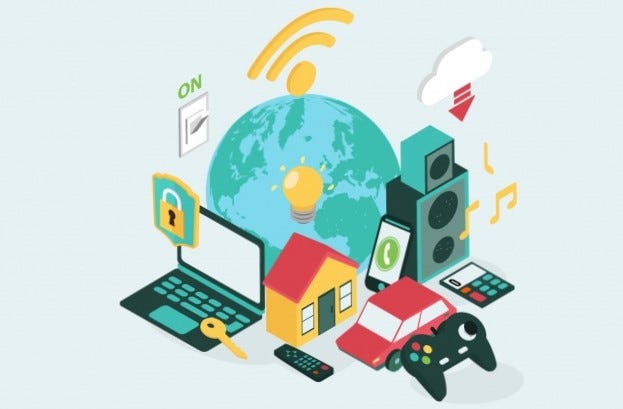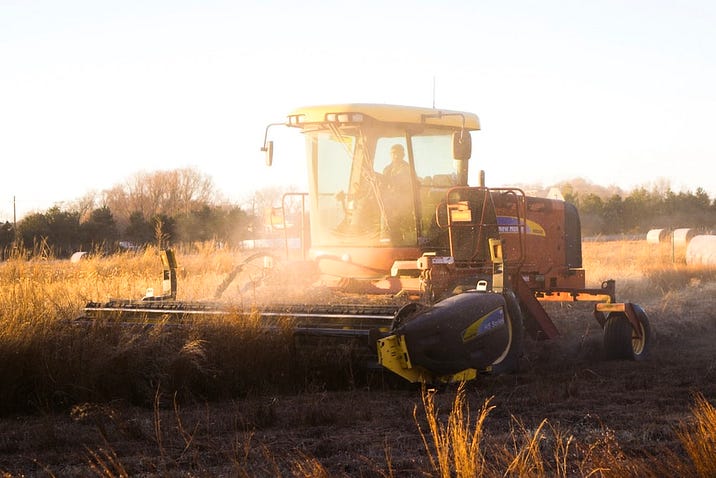My original Medium article lives here
About the Internet of Things in simple terms! 💡
A guide to IoT: All you need to know
About the Internet of Things in simple terms! 💡
The Internet of Things (IoT) at its core relies on a single concept, that is having devices over the world connect to the Internet.
This means it’s able to send, receive information, and act on it. This makes decisions “intelligent” and more well-informed. There are many common examples of IoT in daily life like your phone, your computer, your Google Home, or Alexa. We often see advertisements for smart devices, and often if a light bulb, outlet, doorbell, or thermostat has “smart” in front of it, it uses IoT.
Then how do you know for sure if it’s considered IoT? Well, IoT systems all have the same basic components, let’s break it down!

IoT System 🔎
Sensors/Devices 🎯
IoT relies on gathering the data and then optimizing further decisions based on this data. This aspect of gathering real-time data relies on sensors and devices to gather data from their surroundings. Multiple sensors can be packed in one device, like your mobile phone which has both an accelerometer, camera, light sensor, and GPS.
There are many different sensors that have different applications. A few common sensors like temperature sensors, proximity sensors, pressure sensors, gyroscopic sensors.
These sensors help feed a real-time understanding of the world, allowing the rest of the system to make intelligent decisions.

Connectivity/Cloud ⛅
The next step after all this data is collected is to be sent to the Cloud. Like the sensors before there are various ways and options to get the data to the Cloud to be processed. There are three main factors in play in every option, a tradeoff between power consumption, bandwidth, and range.
Low power consumption, high bandwidth, low range
With a lower power consumption, but still sending lots of data you need to cut back on how far you can send this data. Connections like Ethernet, Bluetooth, or Wifi.
High power consumption, high range, high bandwidth
Using a lot of energy you can send lots of data over a long distance. This is exactly what your smartphone does transmit a lot of data like videos and photos over long distances, but it also has a short battery life (only lasting half the amount of time it’s supposed to 😥).
Low power consumption, high range, low bandwidth
If you’re still stingy about your power and you need a high range, you’ll have to give up on the amount of data you send. Low-Power Wide Area Networks (LPWAN) is a good option, able to send minimal amounts of data with a decent range, and sometimes that’s all you need!
Data Processing/AI 🧠
Once the data is within the cloud, we process the data and extract valuable insights from it. Various different software applications and algorithms are used for this step. Some simple IoT applications may just rely on an IF condition, like If I leave the house then lock the door. More complex IoT systems can employ Artificial Intelligence like Machine Learning to extract more complex and abstract insights from the data. Like automated farming that takes humidity, temperature, past cases, and weather predictions into thought. Or using computer vision to monitor traffic and detect crimes.
End Applications 🤳
In the end, the information is still being acted on. Commands are sent to the device, and the information becomes applicable. This could be a command like print something, or change this setting on the thermostat, or send something like a notification. In the case of sending a user, some information like a notification, text, call, or email relies on an interface like the Ring App. This user interface is where the consumer can view the data, be alerted, and make manual changes.
IoT Product Examples 📂
There are many current IoT devices in use today.
Smarter Homes 🏡
The Internet of Things already has a strong presence in our lives and homes. Homes are becoming more and more automated making living simple and comfortable. Nowadays many people already have a voice assistant like Google Home or Alexa to help manage any day to day tasks. Other devices include smart sensors like Nest (smart thermostat), or Ring (smart doorbell) and August (smart lock). Smart homes offer both the benefit of convenience and energy efficiency.

Personal wearables ⌚
There are many wearable devices on the market, from Fitbits to smartwatches and various fitness trackers. Enabling you to track information like heartbeat and gain insights about your health, fitness, and sleep. Many companies like Apple, Google, Fitbit, and Garmin are working toward a wide range of wearable technology, even some for pets!
IFTTT ✨
IFTTT stands for If This Then That and is a free web-based service and app that helps connect different devices and actions. The applet gets triggered by a certain change and responds with a certain reaction, connecting devices to work together in a specific way. Make your own applet here. For example, when you ask your google home to find your phone or you text a certain phrase to your phone number it turns the ringer to 100% and calls your phone. Or automatically closing your awning when it starts raining with the help of Somfy and Weather Underground.

Creating an applet
They have a wide variety of applets and are able to connect many known apps (Facebook, Instagram) and products (Nest, Fitbit) together. Discover Applets here!

IoT Applications 💡
Healthcare 🩺
The Internet of Medical Things (IoMT) has huge potential in healthcare, opening up the possibility of the remote monitoring and diagnosis of patients. As more and more medical devices are able to connect to the Internet and transmit valuable health data we are able to better streamline clinical workflow ending up with better patient care. IoMT provides real-time more accurate diagnoses, a lower cost of care, and a reduction in errors. We can even use technology like the Fitbit to predict ischemic heart disease or use specialized sensors to predict chronic illnesses.
Agriculture 🌱
IoT opens up a new opportunity in agriculture to minimize operation costs while increasing turnout. There are three main examples I want to mention, precision farming, livestock monitoring, and device automation. Precision farming refers to relying on IoT sensors for the weather, air, soil, humidity to make smart agriculture decisions, and better understand crop conditions. Bio capsules can be fed to livestock to track factors like drinking, nutrition, location, and temperature making sure animals are healthy and well-fed. Autonomous tractors and automated drones for irrigation reduce the work for the farmer in a lot less time.
Retail 🛒
Retail stores and businesses often have to work with large amounts of customer data to make informed business decisions like marketing. IoT helps automate this process of collecting key data while making the in-store experience for a customer smooth. One example is mobile point-of-sale (MPOS) devices that allow stores to accept card payments storewide. Other applications include wearables, iBeacons, and smart shelves to provide new data on customer activity. Retail 2.0 or Brick and Mortar 2.0 focuses on consumer engagement that is personalized in real-time.
Energy ⚡
Our current electric grid is outdated, inefficient, and ill-equipped to keep up with our growing demands for electricity. Our traditional electric grid is made of a complex network of substations, transformers, and transmission lines. A Smart grid relies on the two-way connections from where the power is used and where it’s generated. Sensors are able to better predict break down and contribute to faster restoration of energy. There are reduced maintenance and management costs and lower risk due to higher security.
Smart Cities 🏙
There are lots of data in cities and a lot of decisions to be made, making cities ideal for IoT applications. Smart Cities leverage IoT to gather data from the lights, cameras, meters, and sensors to make decisions on better managing electricity, water, and traffic to name a few. Having a smart garbage collection station like the one in South Korea, Songdo has sensors to detect when the bin is full and sends the trash through pipes. Smart Cities then rely on connectivity to function making 5G crucial, in providing a strong web of connections through the city. 5G has a high bandwidth, able to transmit lots of data with low latency, but only over a short-range meaning, various 5G cells are needed to form a fully connected network.

Fourth industrial revolution aka Industry 4.0 🔨
The Industrial Internet of Things or IoT represents a connected world. Where sensors and analytics drive the actions of industrial devices. Systems are set up to monitor and analyze valuable real-time insights that drive business decisions.
The Future of IoT 🔮
There are two main types of IoT products, Consumer and Enterprise IoT. Consumer IoT is home and personal products brought for the use of an individual or family. While Enterprise IoT is the products and services developed for employees, organizations, and businesses to manage assets and monitor processes. The potential return on IoT has always been present, but IoT was an expensive investment, and considering the return on investment (ROI) it was not worth it.
However, further down the road, the price of IoT software and hardware continues to decrease.
Many more organizations will see IoT as even more of a viable option with a now faster ROI. Years down the line, when IoT becomes a much cheaper investment, we will see more widespread adoption
Imagine a world where every decision is fully informed, billions of tiny covert invisible sensors that provide real-time insights. Ensuring that all resources, assets, and processes are optimized to run smoothly in a system. No more manual data collection is needed, insights form the basis of the automated system, and notifications enable the right person to have the right data at the right time.
Key Concepts📌
- Internet of Things — Having devices connect to the internet!
- IoT System— An IoT system is composed of sensors, the cloud, analyzing the data, and acting on it
- Products— Many IoT products already exist like personal wearables and smart thermostats
- Applications— IoT has plenty of applications such as healthcare, agriculture, and smart cities
- Future Outlook — The future of IoT are billions of unseen sensors collecting data and optimizing decision making
Wanna Learn about IoT? 🎓
Well, to be honest, I only recently starting going deep into IoT.
I’m still just getting into IoT so these are all things I’m currently working on.
Learning device programming, this means mainly focusing on learning languages like C or C++ commonly used to program hardware devices. Arduino has previously been the main microcontroller that I’ve used in projects. Arduino is a good starting point for learning about managing sensors and actuators.
I’ve also worked with RaspberryPi, basically a minicomputer that also has some capacities of the microcontroller like sensors. But it’s strength lies in hosting services and actings as a gateway.
My recent goal is to learn more about gateway development along with cloud services (hoping to apply some of my AI knowledge).
